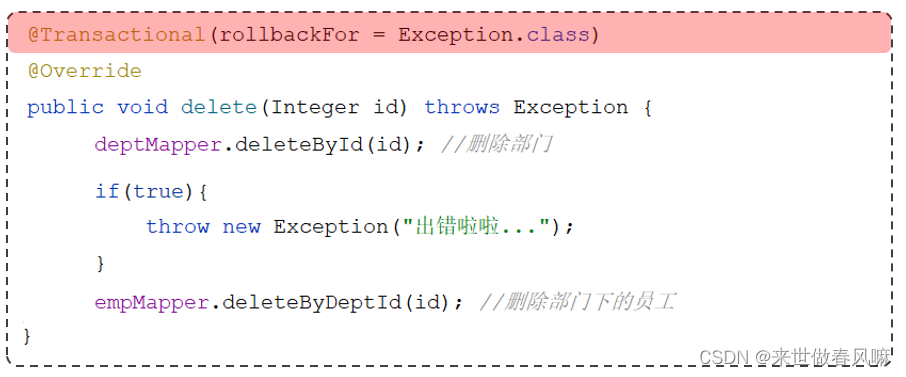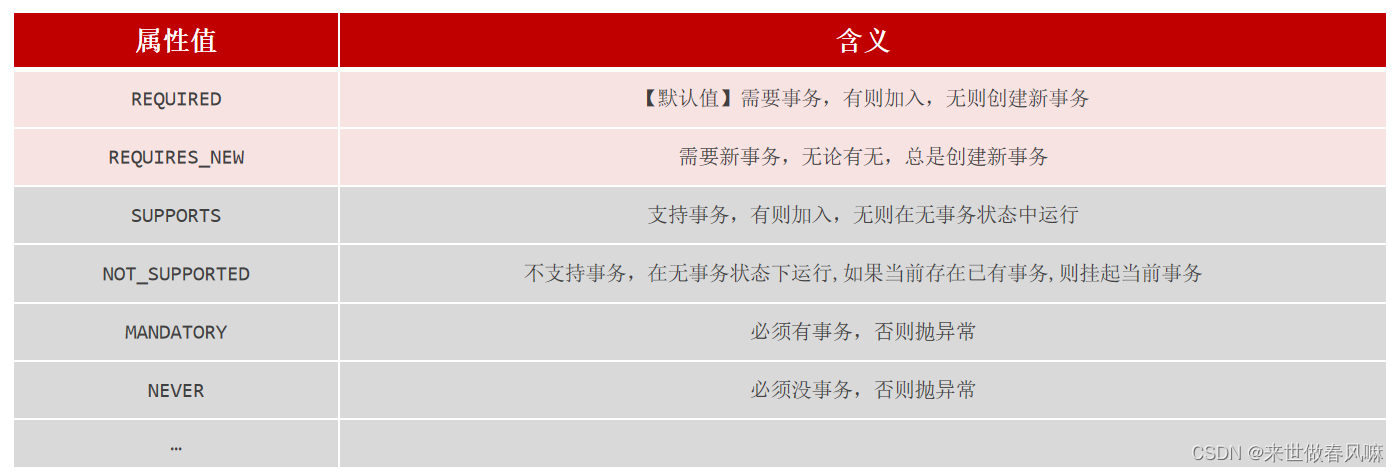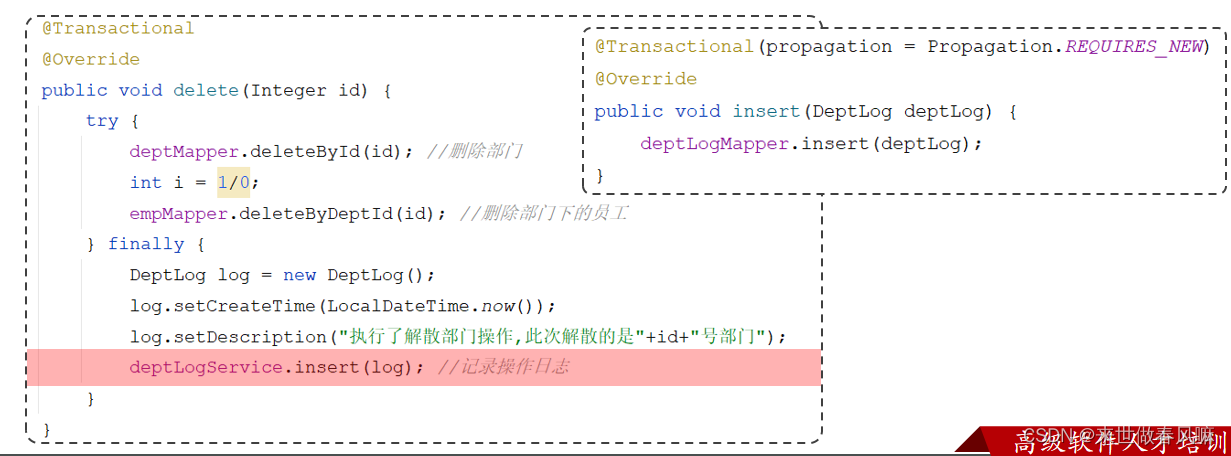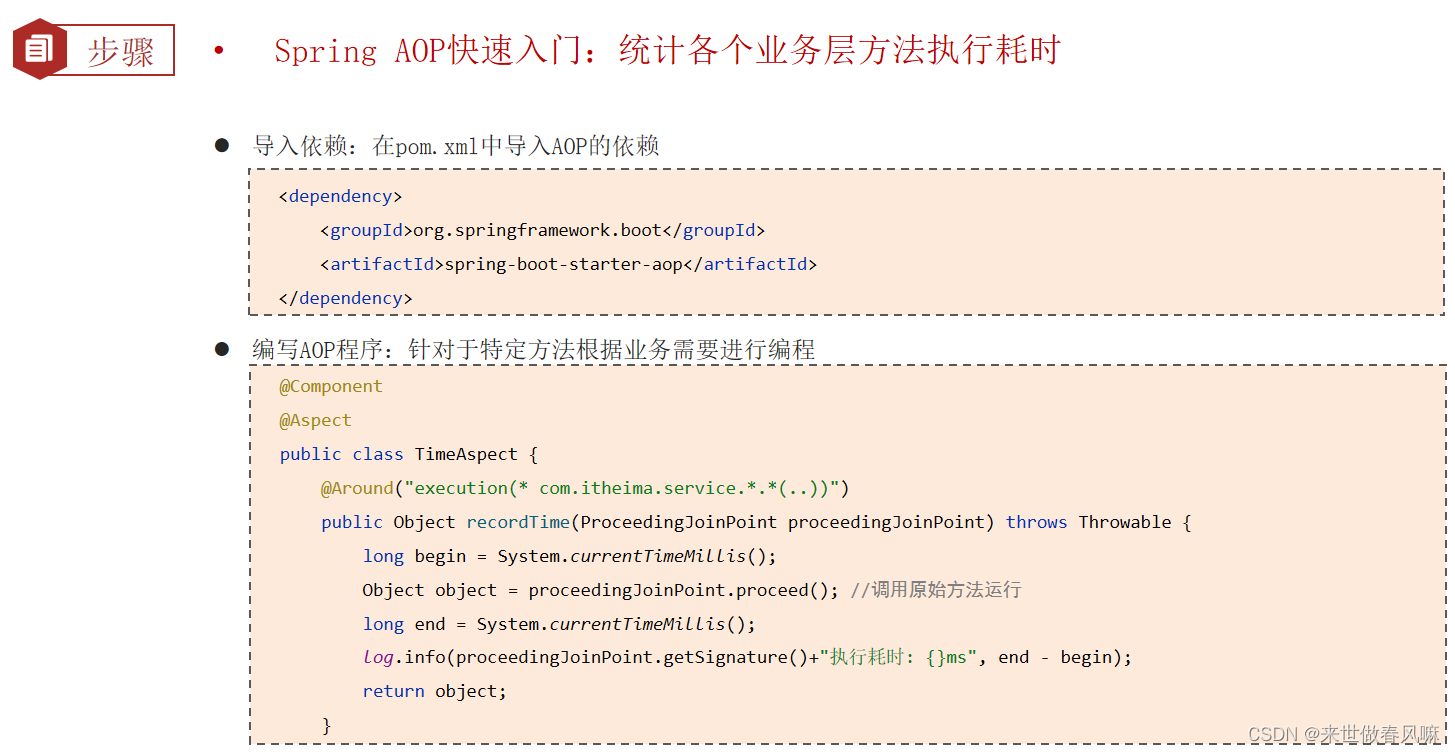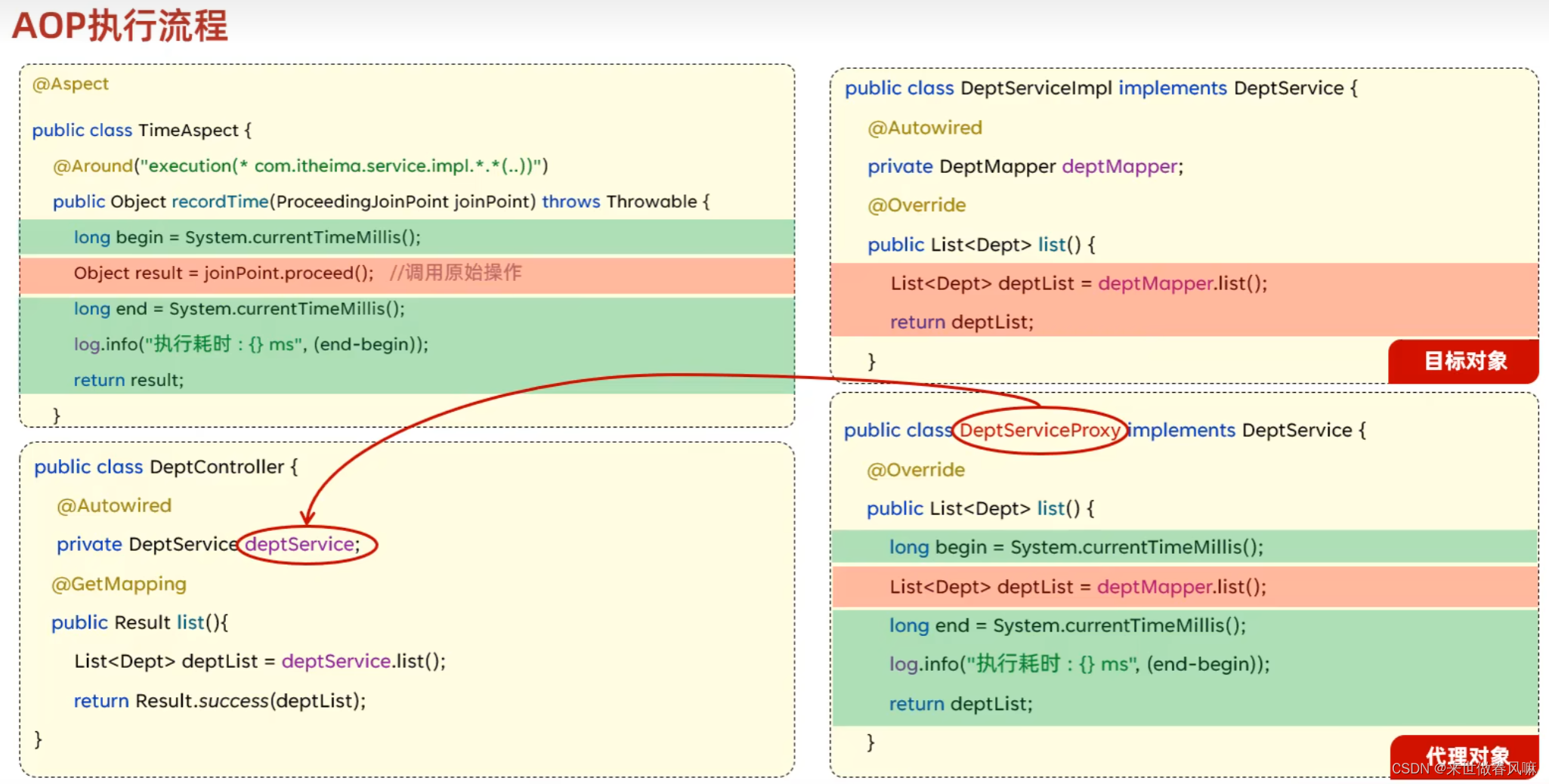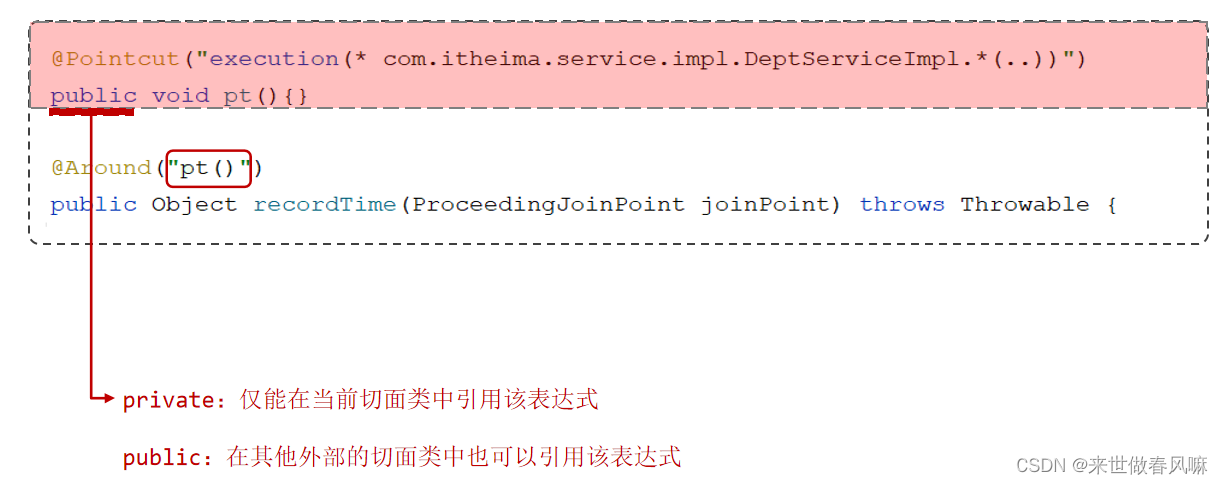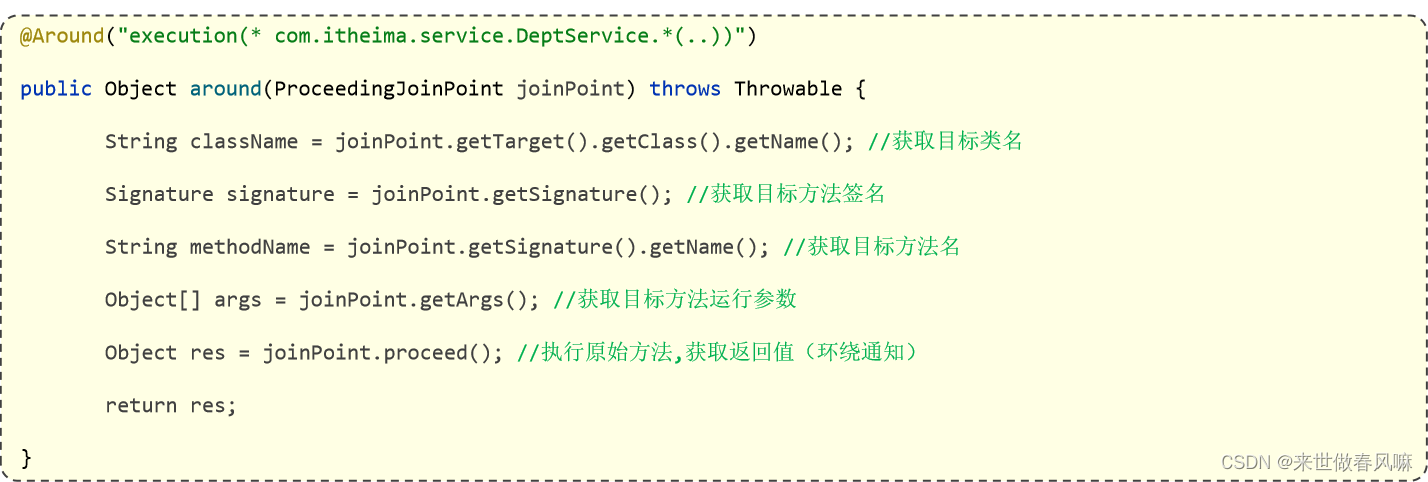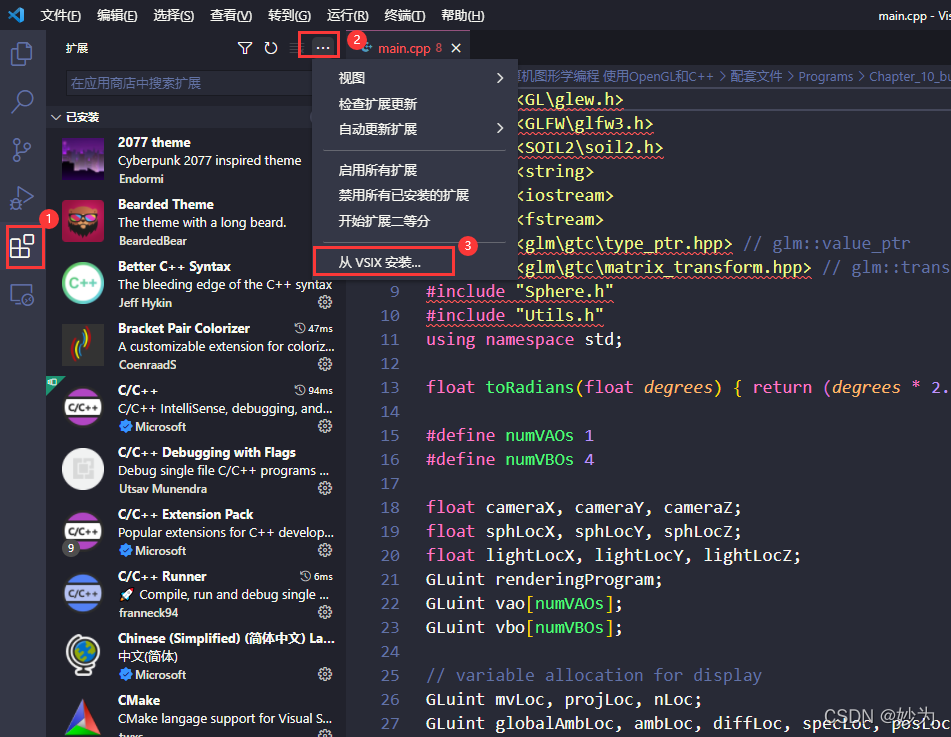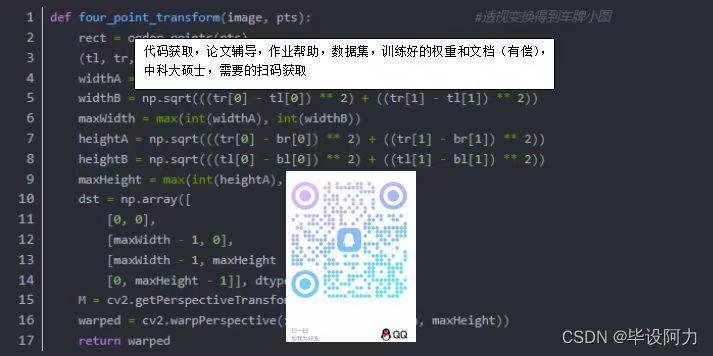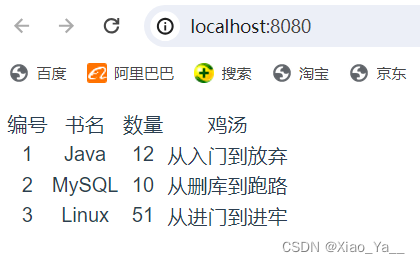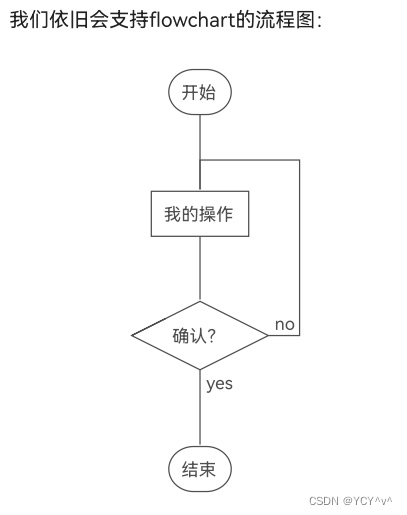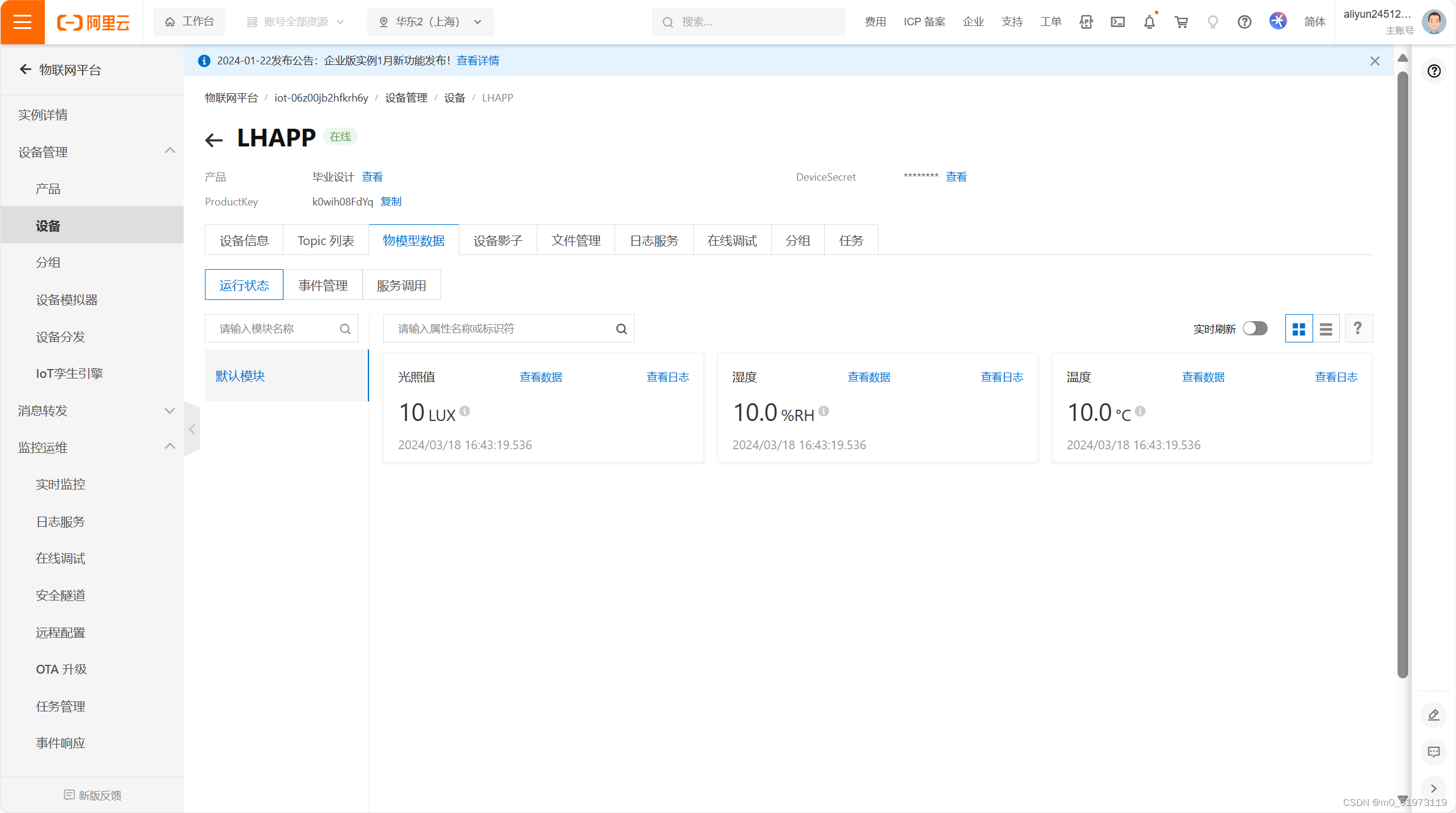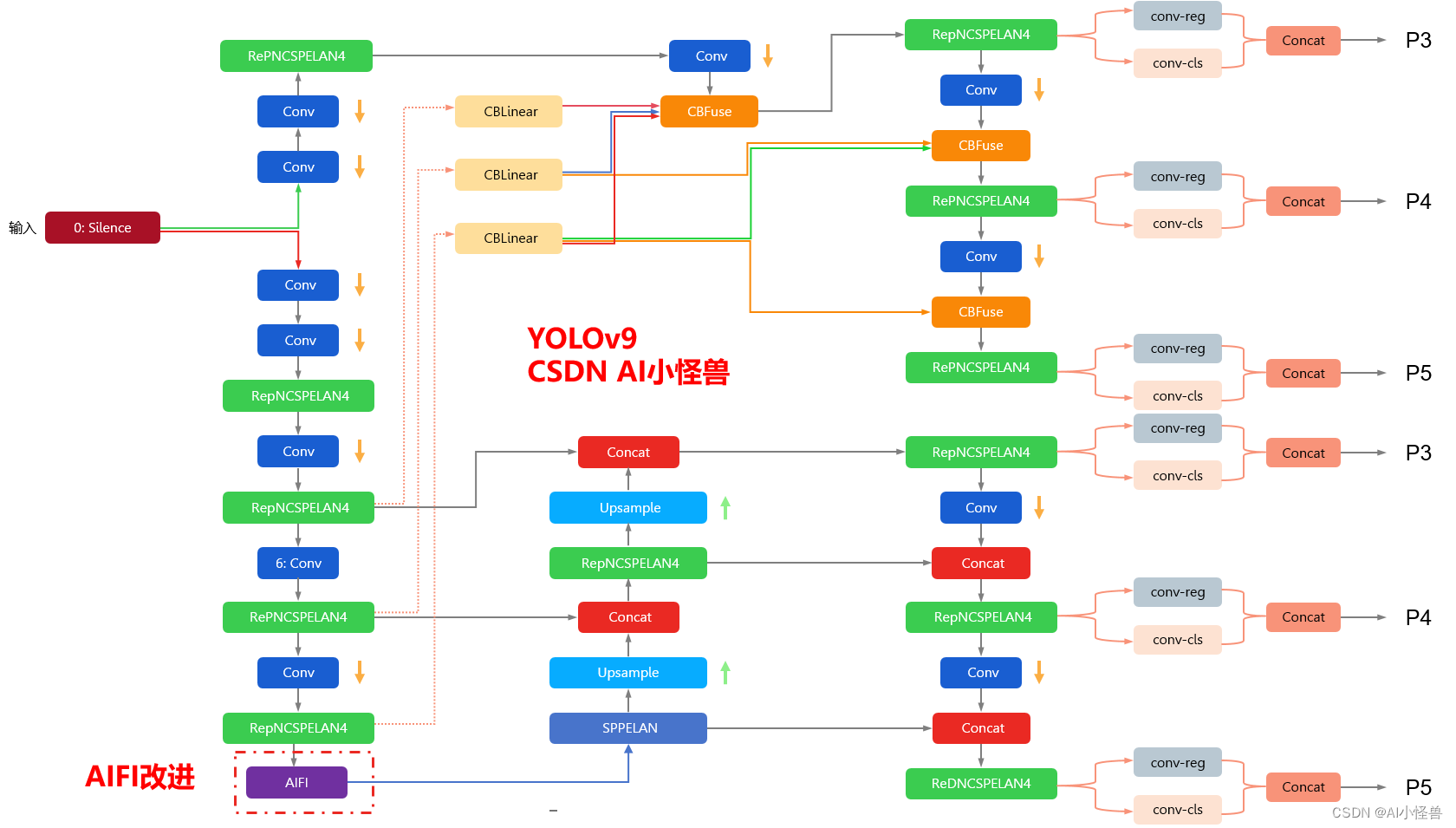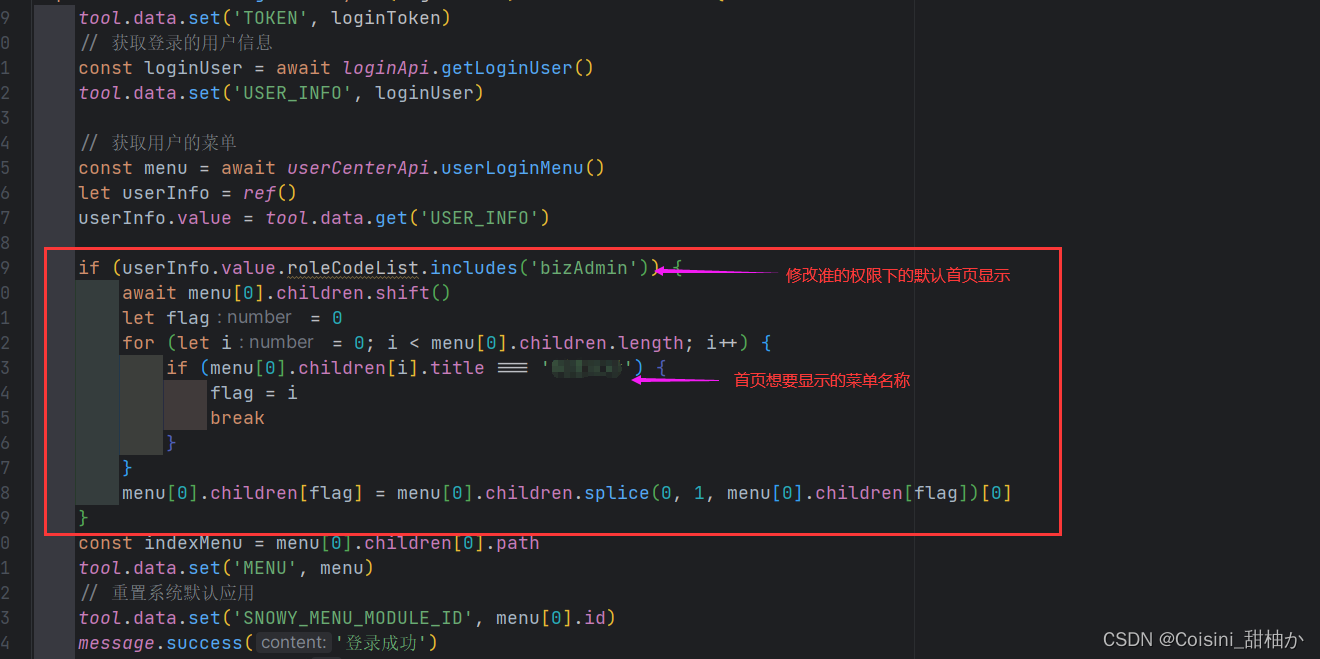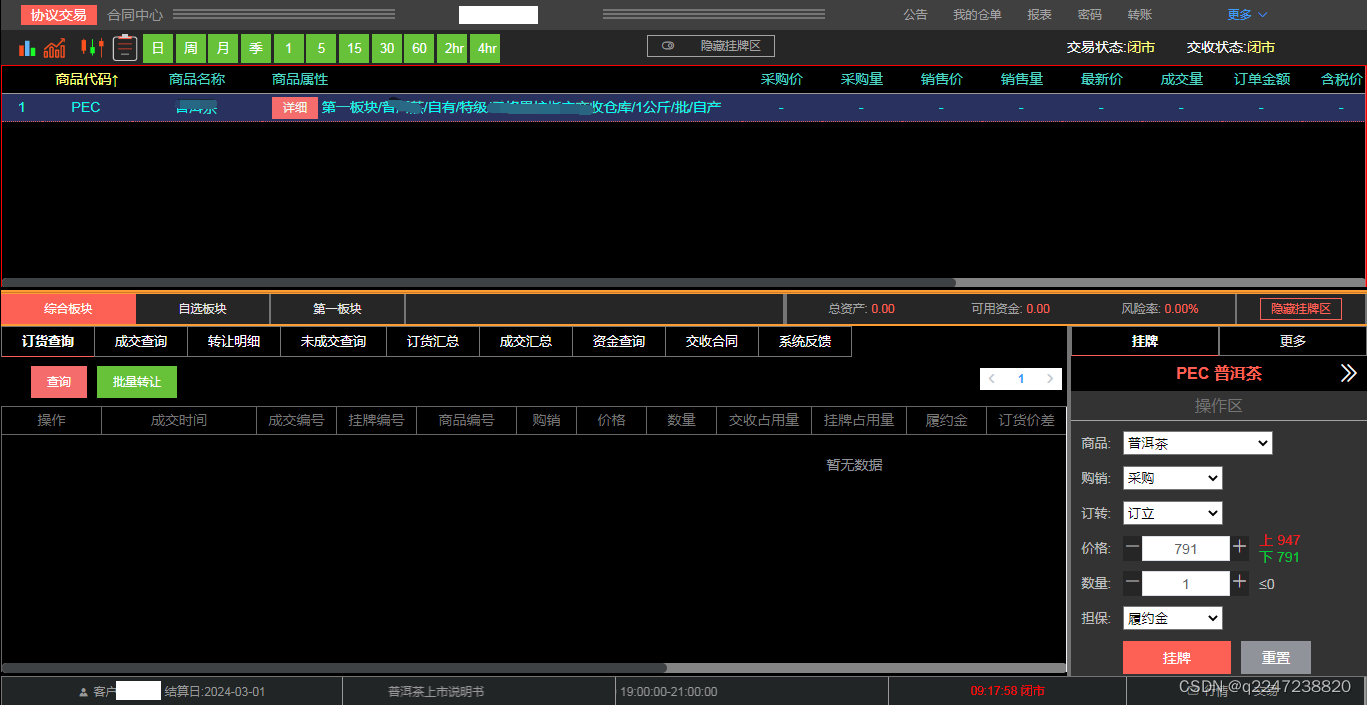一、事务管理
1 事务回顾
概念
事务 是一组操作的集合,它是一个不可分割的工作单位,这些操作 要么同时成功,要么同时失败。
操作
- 开启事务(一组操作开始前,开启事务):start transaction / begin ;
- 提交事务(这组操作全部成功后,提交事务):commit ;
- 回滚事务(中间任何一个操作出现异常,回滚事务):rollback ;
2 Spring 事务管理
- 注解:@Transactional
- 位置:业务(service)层的方法上、类上、接口上
- 作用:将当前方法交给 spring 进行事务管理,方法执行前,开启事务;成功执行完毕,提交事务;出现异常,回滚事务
在 application.yml 配置文件中开启事务管理日志
#spring事务管理日志
logging:
level:
org.springframework.jdbc.support.JdbcTransactionManager: debug

3 事务进阶
3.1 rollbackFor
默认情况下,只有出现 RuntimeException 才回滚异常。rollbackFor 属性用于控制出现何种异常类型,回滚事务。
3.3 propagation
事务传播行为:指的就是当一个事务方法被另一个事务方法调用时,这个事务方法应该如何进行事务控制。
案例:解散部门时,记录操作日志
需求:解散部门时,无论是成功还是失败,都要记录操作日志。
步骤:
- 解散部门:删除部门、删除部门下的员工
- 记录日志到数据库表中
@Transactional
@Override
public void delete(Integer id) throws Exception {
try {
deptMapper.deleteById(id); //根据ID删除部门数据
int i = 1/0;
//if(true){throw new Exception("出错啦...");}
empMapper.deleteByDeptId(id); //根据部门ID删除该部门下的员工
} finally {
DeptLog deptLog = new DeptLog();
deptLog.setCreateTime(LocalDateTime.now());
deptLog.setDescription("执行了解散部门的操作,此次解散的是"+id+"号部门");
deptLogService.insert(deptLog);
}
}
@Transactional(propagation = Propagation.REQUIRES_NEW)
@Override
public void insert(DeptLog deptLog) {
deptLogMapper.insert(deptLog);
}
propagation 属性
- REQUIRED:大部分情况下都是用该传播行为即可。
- REQUIRES_NEW:当我们不希望事务之间相互影响时,可以使用该传播行为。比如:下订单前需要记录日志,不论订单保存成功与否,都需要保证日志记录能够记录成功。
二、 AOP 基础
1 AOP 概述
- AOP:Aspect Oriented Programming(面向切面编程、面向方面编程),其实就是面向特定方法编程。
- 场景:
案例部分功能运行较慢,定位执行耗时较长的业务方法,此时需要统计每一个业务方法的执行耗时- 实现:
动态代理是面向切面编程最主流的实现。而 SpringAOP 是 Spring 框架的高级技术,旨在管理 bean 对象的过程中,主要通过底层的动态代理机制,对特定的方法进行编程(功能增强)。
2 AOP 快速入门
Spring AOP 快速入门:统计各个业务层方法执行耗时
<!--AOP-->
<dependency>
<groupId>org.springframework.boot</groupId>
<artifactId>spring-boot-starter-aop</artifactId>
</dependency>
@Slf4j
@Component
//@Aspect //AOP类
public class TimeAspect {
@Around("execution(* com.itheima.service.impl.DeptServiceImpl.*(..))") //切入点表达式
public Object recordTime(ProceedingJoinPoint joinPoint) throws Throwable {
//1. 记录开始时间
long begin = System.currentTimeMillis();
//2. 调用原始方法运行
Object result = joinPoint.proceed();
//3. 记录结束时间, 计算方法执行耗时
long end = System.currentTimeMillis();
log.info(joinPoint.getSignature()+"方法执行耗时: {}ms", end-begin);
return result;
}
}
常见的应用场景如下:
- 记录系统的操作日志
- 权限控制
- 事务管理:我们前面所讲解的 Spring 事务管理,底层其实也是通过 AOP 来实现的,只要添加 @Transactional 注解之后,AOP 程序自动会在原始方法运行前先来开启事务,在原始方法运行完毕之后提交或回滚事务
AOP 优势:
- 代码无侵入:没有修改原始的业务方法,就已经对原始的业务方法进行了功能的增强或者是功能的改变
- 减少了重复代码
- 提高开发效率
- 维护方便
3 AOP 核心概念
- 连接点:JoinPoint,可以被AOP控制的方法(暗含方法执行时的相关信息)
- 通知:Advice,指哪些重复的逻辑,也就是共性功能(最终体现为一个方法)
- 切入点:PointCut,匹配连接点的条件,通知仅会在切入点方法执行时被应用
- 切面:Aspect,描述通知与切入点的对应关系(通知+切入点)
- 目标对象:Target,通知所应用的对象
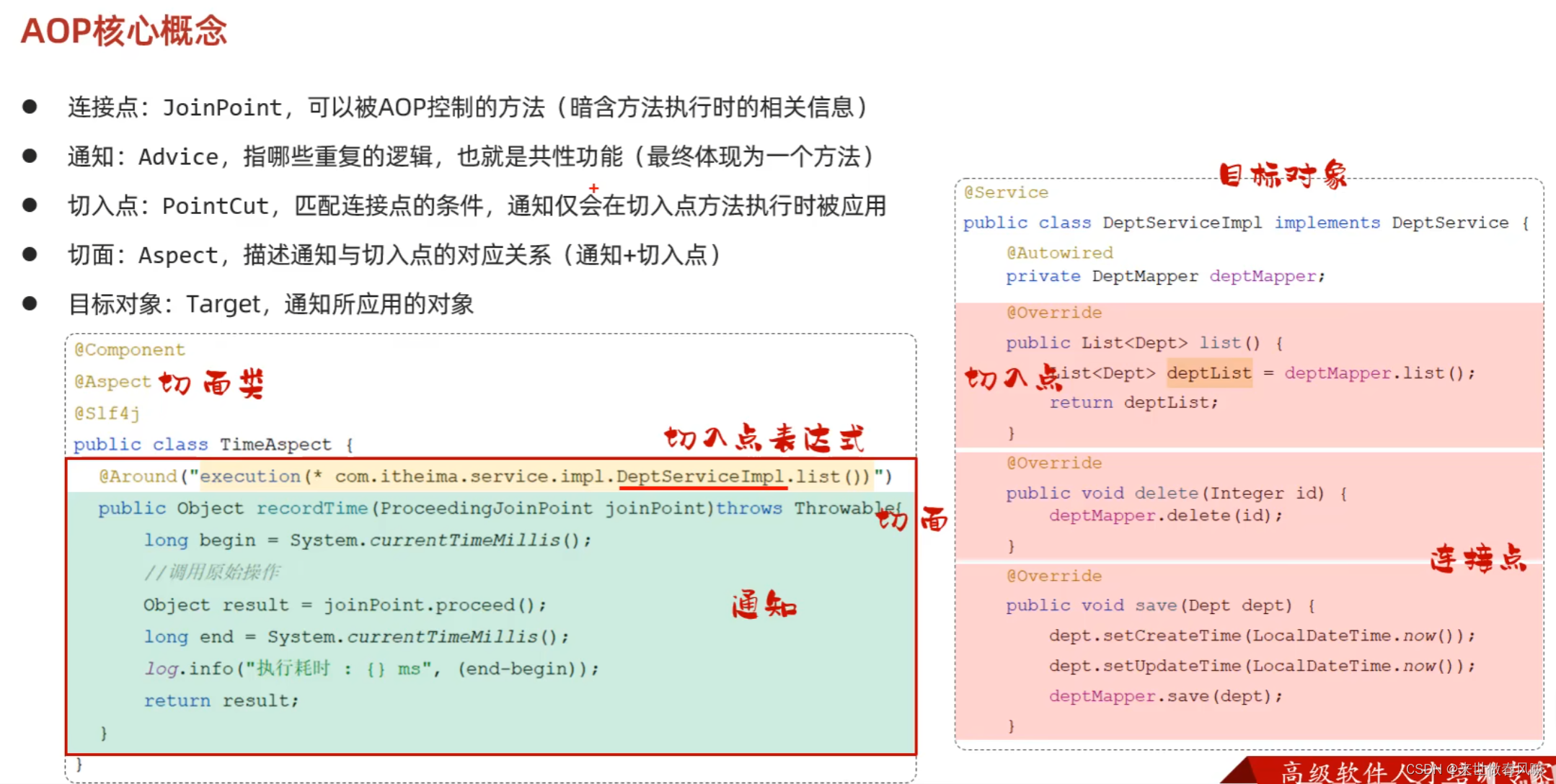
AOP 执行流程
三、AOP 进阶
1 通知类型
Spring 中 AOP 的通知类型:
- @Around:环绕通知,此注解标注的通知方法在目标方法前、后都被执行
- @Before:前置通知,此注解标注的通知方法在目标方法前被执行
- @After :后置通知,此注解标注的通知方法在目标方法后被执行,无论是否有异常都会执行
- @AfterReturning : 返回后通知,此注解标注的通知方法在目标方法后被执行,有异常不会执行
- @AfterThrowing : 异常后通知,此注解标注的通知方法发生异常后执行
注意事项
- @Around 环绕通知需要自己调用 ProceedingJoinPoint.proceed() 来让原始方法执行,其他通知不需要考虑目标方法执行
- @Around 环绕通知方法的返回值,必须指定为 Object,来接收原始方法的返回值。
@Slf4j
@Component
@Aspect
public class MyAspect1 {
@Pointcut("execution(* com.itheima.service.impl.DeptServiceImpl.*(..))")
public void pt(){}
@Before("pt()")
public void before(){
log.info("before ...");
}
@Around("pt()")
public Object around(ProceedingJoinPoint proceedingJoinPoint) throws Throwable {
log.info("around before ...");
//调用目标对象的原始方法执行
Object result = proceedingJoinPoint.proceed();
log.info("around after ...");
return result;
}
@After("pt()")
public void after(){
log.info("after ...");
}
@AfterReturning("pt()")
public void afterReturning(){
log.info("afterReturning ...");
}
@AfterThrowing("pt()")
public void afterThrowing(){
log.info("afterThrowing ...");
}
}
@PointCut
该注解的作用是将公共的切点表达式抽取出来,需要用到时引用该切点表达式即可。
2 通知顺序
当有多个切面的切入点都匹配到了目标方法,目标方法运行时,多个通知方法都会被执行。
- 不同切面类中,默认按照切面类的 类名字母排序:
目标方法前的通知方法:字母排名靠前的先执行
目标方法后的通知方法:字母排名靠前的后执行- 用 @Order(数字) 加在切面类上来控制顺序
目标方法前的通知方法:数字小的先执行
目标方法后的通知方法:数字小的后执行
3 切入点表达式
- 切入点表达式:描述切入点方法的一种表达式
- 作用:主要用来决定项目中的哪些方法需要加入通知
- 常见形式:
- execution(……):根据方法的签名来匹配
- @annotation(……) :根据注解匹配
3.1 execution
execution 主要根据方法的返回值、包名、类名、方法名、方法参数等信息来匹配,语法为:
execution(访问修饰符? 返回值 包名.类名.?方法名(方法参数) throws 异常?)
其中带 ? 的表示可以省略的部分
- 访问修饰符:可省略(比如: public、protected)
- 包名.类名: 可省略
- throws 异常:可省略(注意是方法上声明抛出的异常,不是实际抛出的异常)
可以使用通配符描述切入点
- * :单个独立的任意符号,可以通配任意返回值、包名、类名、方法名、任意类型的一个参数,也可以通配包、类、方法名的一部分
execution(* com.*.service.*.update*(*))
- … :多个连续的任意符号,可以通配任意层级的包,或任意类型、任意个数的参数
execution(* com.itheima..DeptService.*(..))
注意事项
- 根据业务需要,可以使用 且(&&)、或(||)、非(!) 来组合比较复杂的切入点表达式。
//切面类
@Slf4j
//@Aspect
@Component
public class MyAspect6 {
//@Pointcut("execution(public void com.itheima.service.impl.DeptServiceImpl.delete(java.lang.Integer))")
//@Pointcut("execution(void com.itheima.service.impl.DeptServiceImpl.delete(java.lang.Integer))")
//@Pointcut("execution(void delete(java.lang.Integer))") //包名.类名不建议省略
//@Pointcut("execution(void com.itheima.service.DeptService.delete(java.lang.Integer))")
//@Pointcut("execution(void com.itheima.service.DeptService.*(java.lang.Integer))")
//@Pointcut("execution(* com.*.service.DeptService.*(*))")
//@Pointcut("execution(* com.itheima.service.*Service.delete*(*))")
//@Pointcut("execution(* com.itheima.service.DeptService.*(..))")
//@Pointcut("execution(* com..DeptService.*(..))")
//@Pointcut("execution(* com..*.*(..))")
//@Pointcut("execution(* *(..))") //慎用
@Pointcut("execution(* com.itheima.service.DeptService.list()) || " +
"execution(* com.itheima.service.DeptService.delete(java.lang.Integer))")
private void pt(){}
@Before("pt()")
public void before(){
log.info("MyAspect6 ... before ...");
}
}
书写建议
- 所有业务 方法名 在命名时尽量 规范,方便切入点表达式快速匹配。如:查询类方法都是 find 开头,更新类方法都是 update 开头。
- 描述切入点方法通常 基于接口描述,而不是直接描述实现类,增强拓展性。
- 在满足业务需要的前提下,尽量缩小切入点的匹配范围。如:包名匹配尽量不使用 …,使用 * 匹配单个包。
3.2 @annotation
@annotation 切入点表达式,用于匹配标识有特定注解的方法。
@annotation(com.itheima.anno.Log)

实现步骤:
- 编写自定义注解
- 在业务类要做为连接点的方法上添加自定义注解
@Retention(RetentionPolicy.RUNTIME)
@Target(ElementType.METHOD)
public @interface MyLog {
}
//切面类
@Slf4j
//@Aspect
@Component
public class MyAspect7 {
@Pointcut("@annotation(com.itheima.aop.MyLog)")
private void pt(){}
@Before("pt()")
public void before(){
log.info("MyAspect7 ... before ...");
}
}
4 连接点
在 Spring 中用 JoinPoint 抽象了连接点,用它可以获得方法执行时的相关信息,如目标类名、方法名、方法参数等。
- 对于 @Around 通知,获取连接点信息只能使用 ProceedingJoinPoint
- 对于其他四种通知,获取连接点信息只能使用 JoinPoint ,它是 ProceedingJoinPoint 的父类型
四、AOP 案例
1 需求
需求:将案例中增、删、改相关接口的操作日志记录到数据库表中
- 就是当访问部门管理和员工管理当中的增、删、改相关功能接口时,需要详细的操作日志,并保存在数据表中,便于后期数据追踪。
操作日志信息包含:
- 操作人、操作时间、执行方法的全类名、执行方法名、方法运行时参数、返回值、方法执行时长
2 分析
- 需要对所有业务类中的增、删、改 方法添加统一功能,使用 AOP 技术最为方便
- 由于增、删、改 方法名没有规律,可以自定义 @Log 注解完成目标方法匹配
3 步骤
准备工作
- 引入 AOP 的起步依赖
- 导入资料中准备好的数据库表结构,并引入对应的实体类
编码实现
- 自定义注解 @Log
- 定义切面类,完成记录操作日志的逻辑
@Retention(RetentionPolicy.RUNTIME)
@Target(ElementType.METHOD)
public @interface Log {
}
@Slf4j
@Component
@Aspect //切面类
public class LogAspect {
@Autowired
private HttpServletRequest request;
@Autowired
private OperateLogMapper operateLogMapper;
@Around("@annotation(com.itheima.anno.Log)")
public Object recordLog(ProceedingJoinPoint joinPoint) throws Throwable {
//操作人ID - 当前登录员工ID
//获取请求头中的jwt令牌, 解析令牌
String jwt = request.getHeader("token");
Claims claims = JwtUtils.parseJWT(jwt);
Integer operateUser = (Integer) claims.get("id");
//操作时间
LocalDateTime operateTime = LocalDateTime.now();
//操作类名
String className = joinPoint.getTarget().getClass().getName();
//操作方法名
String methodName = joinPoint.getSignature().getName();
//操作方法参数
Object[] args = joinPoint.getArgs();
String methodParams = Arrays.toString(args);
long begin = System.currentTimeMillis();
//调用原始目标方法运行
Object result = joinPoint.proceed();
long end = System.currentTimeMillis();
//方法返回值
String returnValue = JSONObject.toJSONString(result);
//操作耗时
Long costTime = end - begin;
//记录操作日志
OperateLog operateLog = new OperateLog(null,operateUser,operateTime,className,methodName,methodParams,returnValue,costTime);
operateLogMapper.insert(operateLog);
log.info("AOP记录操作日志: {}" , operateLog);
return result;
}
}
/**
* 员工管理Controller
*/
@Slf4j
@RestController
@RequestMapping("/emps")
public class EmpController {
@Autowired
private EmpService empService;
@Log
@DeleteMapping("/{ids}")
public Result delete(@PathVariable List<Integer> ids){
log.info("批量删除操作, ids:{}",ids);
empService.delete(ids);
return Result.success();
}
}

